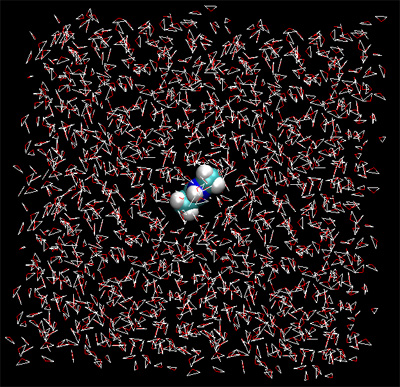
(Note: These tutorials are meant to provide
illustrative examples of how to use the AMBER software suite to carry out
simulations that can be run on a simple workstation in a reasonable period of
time. They do not necessarily provide the optimal choice of parameters or
methods for the particular application area.)
Copyright Ross Walker 2004
TUTORIAL 6 - AMBER 9 VERSION
A Coupled Potential QM/MM Simulation
By Ross Walker

PLEASE NOTE THIS TUTORIAL IS FOR AMBER 9 ONLY.
An Amber 8 version of this tutorial is available
here.
Although Amber 8 is NOT
recommended for QM/MM simulations.
You should consider upgrading to AMBER 9.
With the version 9 release of AMBER comes the ability to do fast and accurate coupled potential semi-empirical QM/MM simulations with full treatment of long range electrostatics (PME) or Generalized Born implicit solvent simulations. This tutorial uses the theory described section 6.4 of the AMBER manual in which one part of the system can be represented quantum mechanically while the rest of the system is represented using the classical AMBER force field.
This implementation is a significant advance over the very basic AMBER 8 QM/MM implementation and the improvements are such that AMBER 8 is no longer recommended for QM/MM simulations. If you intend to run QM/MM simulations you should seriously consider upgrading to AMBER 9.
This tutorial explains how to set up a periodic boundary QM/MM simulation using AMBER 9. The procedure is significantly different from AMBER 8 but at the same time has been greatly simplified. In AMBER 9 all of the QM/MM functionality is implemented within the standard sander executable.
This tutorial consists of 4 sections:
section1.htm : Setting up NMA
section2.htm : Classical MD
section3.htm : QM/MM MD
section4.htm : Comparing the results
(Note: These tutorials are meant to provide
illustrative examples of how to use the AMBER software suite to carry out
simulations that can be run on a simple workstation in a reasonable period of
time. They do not necessarily provide the optimal choice of parameters or
methods for the particular application area.)
Copyright Ross Walker 2004